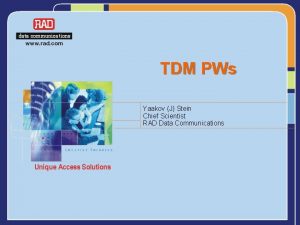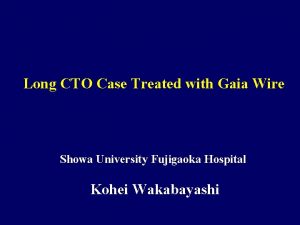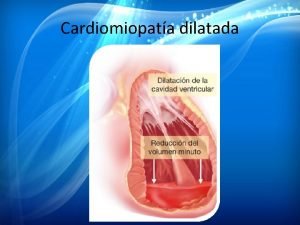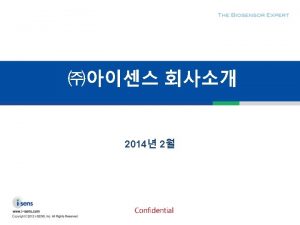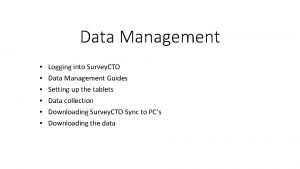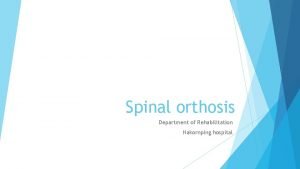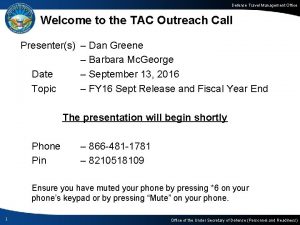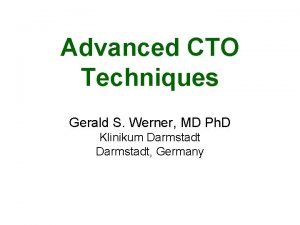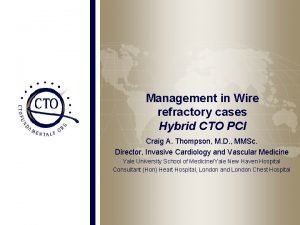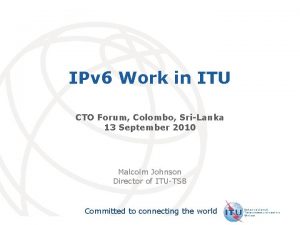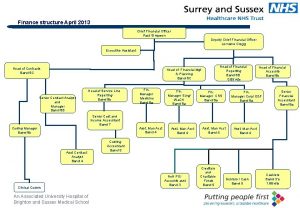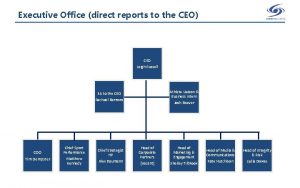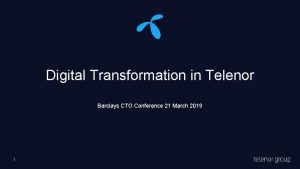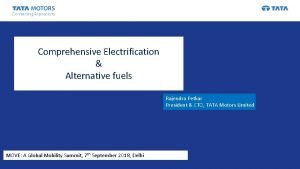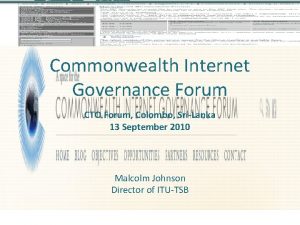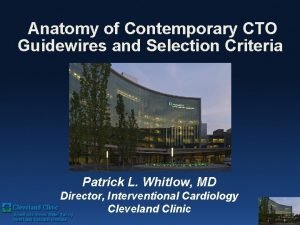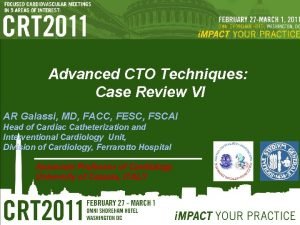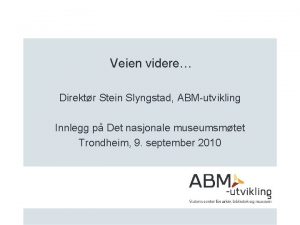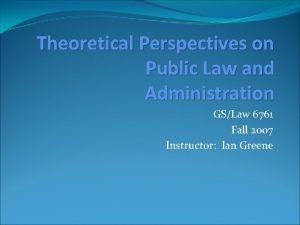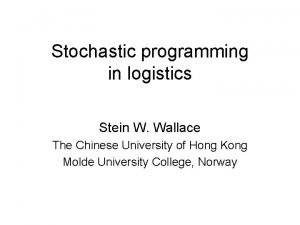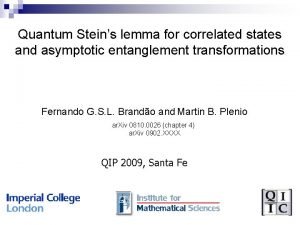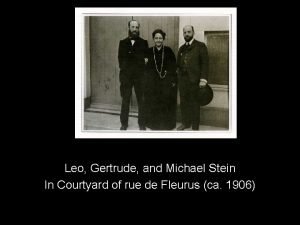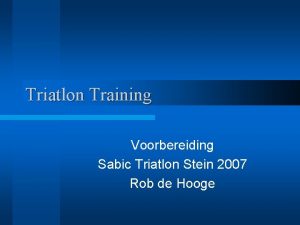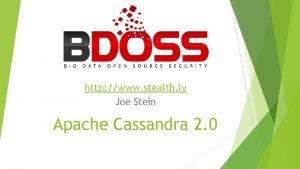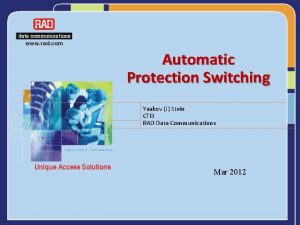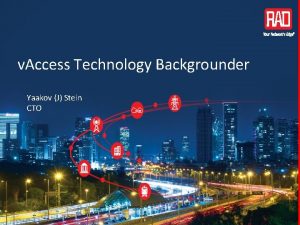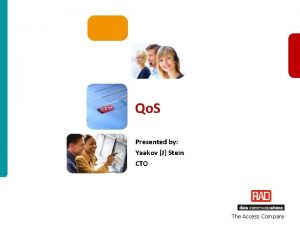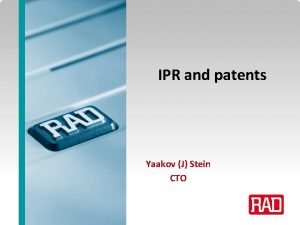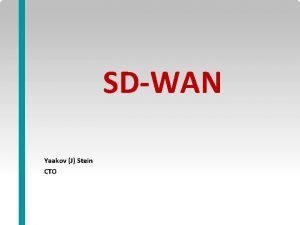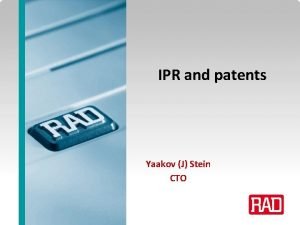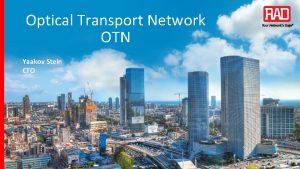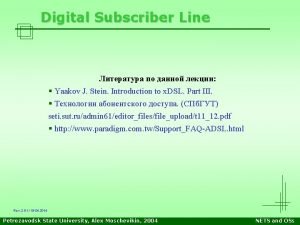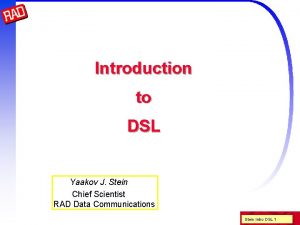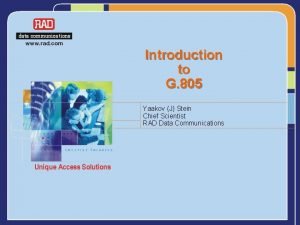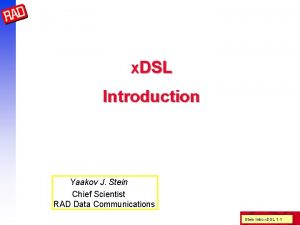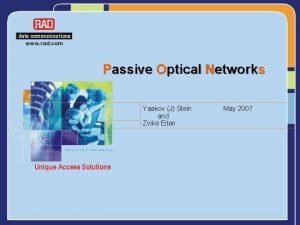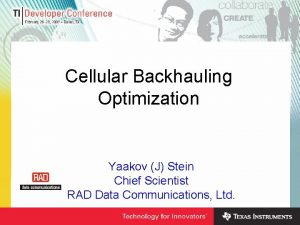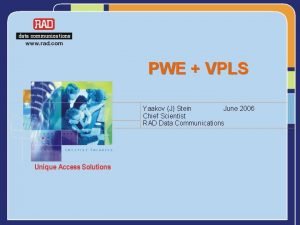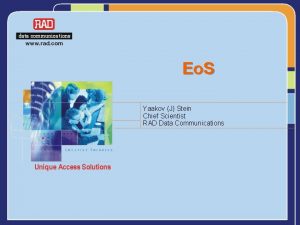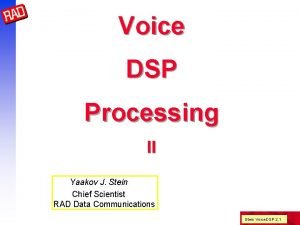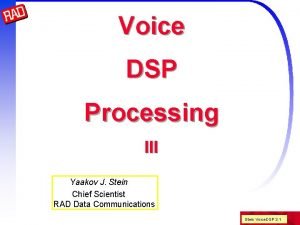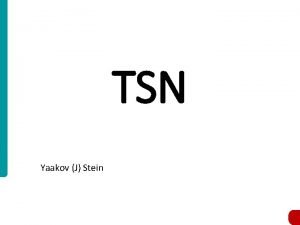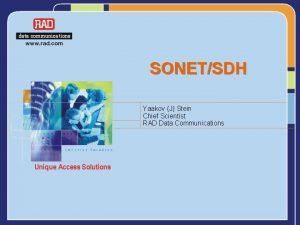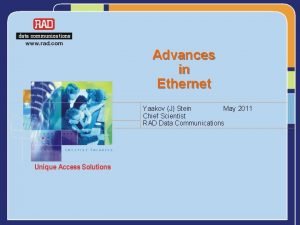Introduction to 5 G Yaakov J Stein CTO







































- Slides: 39

Introduction to 5 G Yaakov (J) Stein CTO

Agenda • Generations of cellular technologies • 5 G? Why? • 5 G goals • NR air interface • RAN and Functional splits • 5 G NG core • Network slicing • Timing 5 G 2

Generations of cellular technologies 1 G 2 G 3 GPP releases era services 3 G 4 G 5 G 4 - 7 8 -9, 10 -14 15, 16 1980 s 1990 s 2000 s 2010 s 2020 s analog voice digital voice messages WB voice packet data voice, video Internet, apps everything 0 100 kbps (GPRS) 10 Mbps (HSPA) 100+ Mbps (LTE/LTE-A) 10 Gbps (NR) 500 ms 10 s ms 5 ms devices data rate delay 5 G 3

What’s wrong with 4 G? to ed lop ns ve tio de ita ing lim be 4 G is ss 5 G dre ad 4 G made possible: • fast Internet access • video reception and creation • apps relying on location and identity • always-on behavior but suffers from numerous limitations: • for some applications: data-rate too low • for some applications: delay too high • too few simultaneous connections (insufficient density) • coverage too low / drop rate too high • weak (if any) Qo. S guarantees • price per bit too high (inefficient spectral use) • power consumption too high (and thus battery life too low) • poor support for new applications/markets (e. g. , Io. T, AR/VR, connected cars) • no support for new mobility requirements (mobile hot spots, high speed) • insufficient security/privacy 5 G 4

5 G importance 5 G will enable entirely new market segments • ubiquitous wireless broadband (e. MBB) – Wireless-to-the-Premises – broadband on high-speed trains, at events and in crowds • massive Io. T (20 B Io. T devices connected by 2020) • V 2 X (vehicle to vehicle, vehicle to infrastructure) • Virtual Reality / Augmented Reality A study led by Qualcomm finds that by 2035 • $3. 5 trillion in 5 G direct yearly revenues • $12. 3 trillion worth of goods and services will be enabled by 5 G • 22 million jobs will be attributable to 5 G • 5 G will boost global GDP growth by $3 trillion (compared to 2020) about the GDP of India 5 G 5

5 G is coming fast! You may think that 5 G is futuristic, but it is coming fast In June 2016, 3 GPP accelerated the standardization work-plan • 5 G phase 1 (release 15) finished by June 2018 for trials in 2019 • 5 G phase 2 (release 16) finished by March 2020 and SPs/vendors are not even waiting for 2019! • AT&T (Ericsson, Samsung, Nokia, Intel) are in trials in 5 cities and hope to roll out nationwide by late 2018 • Verizon (Nokia, Ericsson) conducting WTTP trials (10 G connectivity!) • Telus (Huawei) demoed Wireless-to-the-Premises with Huawei • Orange (Ericsson) announced testing of selected use cases • Softbank and China Mobile installing thousands of massive MIMO towers • NTT DOCOMO (Ericsson, Intel) trial environment in central Tokyo • KT promised 5 G coverage along Highway 50 ahead of 2018 Olympic games • Airtel. BSE, Vodafone India, Reliance Jio (ZTE) have conducted trials • You’ll see 5 G in 2019 for sure Qualcomm CEO Steve Mollenkopf 5 G 6

IMT-2020 goals The ITU is defining performance targets for 5 G that are 10 to 100 times more than 4 G* : • Peak data rate (20 Gbps/device) • User experienced data rate (100 Mbps) • Latency (1 ms) • Mobility (500 km/h and seamless transfer) • Connection density (106 devices/km 2) • Energy efficiency (1/100 Joule/bit for both air interface and network) • Spectrum efficiency (3 times the bps/Hz of LTE-A) • Area traffic capacity (10 Mbps/m 2) However, it is not possible to attain all of these at the same time so 5 G recognizes usage scenarios and includes mechanisms to separate traffic types (slicing) * ITU-R M. 2083 -0 5 G 7

5 G changes all cellular segments FDMA, TDMA, CDMA, NR Air Interface User Equipment Radio Access Network (backhauling) GRAN, GERAN, UTRAN, E-UTRAN, Next. Gen (R)AN Base Station BTS, NB, e. NB, g. NB core network NSS, UMTS core, EPC, NGCN Multiple 4 G/5 G co-existence options have been proposed • Standalone (e. g. , e. NB-EPC and g. NB-NGCN) • Non-Standalone (g. NB-LTE-EPC, g. NB-EPC, e. NB-NR, e. NB-NGCN, . . . ) Initial 5 G will be Non-Standalone g. NB connecting to LTE RAN and EPC 5 G 8

3 GPP organization 5 G 9

Some important 3 GPP documents consult http: //www. 3 gpp. org/specifications/specification-numbering Requirements 22. 261 General 22. 861 Io. T 22. 862 Critical communications 22. 863 e. MBB 22. 886 V 2 V 38. 913 Access Technologies Architecture 23. 799 Study 23. 501 System Architecture 23. 502 System Flows Security 33. 899 Study 33. 501 normative doc NR 38. 101 -1 Range 1 (< 6 GHz) spectrum 38. 101 -2 Range 2 (> 6 GHz) spectrum 38. 201 Physical layer; General description 38. 202 Services provided by the physical layer 38. 211 Physical channels and modulation 38. 212 Multiplexing and channel coding 38. 213 Physical layer procedures for control 38. 214 Physical layer procedures for data 38. 215 Physical layer measurements 38. 801 Report (including migration options) 38. 806 Functional splits report 38. 816 Lower layer split 5 G 10

Upgrading the air interface How can we improve the radio link from the g. Nb to UE ? • more efficient modulation (New Radio) • wider spectral bands (100 Mhz, 1 GHz), which requires – new RF bands (sub-1 GHz, 24/28 GHz mm. Wave, 30 -90 GHz ? ) – use of licensed/unlicensed unshared/shared spectrum • higher cell density (i. e. , many more antennas) – small cells – Het. Nets • massive MIMO – massive is defined as 16 or more antennas (4 -by-4 array) – 5 G envisages up to 256 antennas • LTE: 4 UL/8 DL 802. 11 n: 4, 802. 11 ac: 8 • in LTE’s Co. MP UE connects to multiple cells to reduce intercell interference – < 6 GHz use multipath for spatial mux and multiuser MIMO – > 6 GHz use coherent beamforming (i. e. , personal cells) 5 G 11

NR evolved from LTE Gen Modulation Duplexing MA MIMO 1 G analog FM FDD FDMA 2 G QPSK/MSK FDD TD/FD/CD-MA 3 G x. PSK FDD/TDD WCDMA 4 G - DL OFDM 4 G - UL QPSK/16 QAM/64 QAM SC-OFDM QPSK/16 QAM/64 QAM OFDMA FDD/TDD 1 x 1/2 x 2/4 x 4 SC-FDMA Unlike previous generations, 5 G physical layer builds on the 4 G one However, it frees up many of the constraints in order to • enable higher data rates • enable lower latencies • reduce power consumption per bit • enable co-existence of multiple application requirements 5 G 12

LTE OFDM scheme (1) LTE defined 1. 4, 3, 5, 10, 15, and 20 MHz channel bandwidths Subcarrier spacing is always 15 k. Hz and thus OFDM requires the symbol rate to be 15 ksps (30, 60, or 90 kbps) and the symbol duration to be 1/15 k. Hz = 66. 7 μsec The total number of subcarriers is constrained to be a multiple of 12 (subcarriers are allocated in blocks of 12 subcarriers each) Channel BW subcarriers RBs useable BW 1. 4 MHz 72 6 1. 08 MHz 3 MHz 180 15 2. 7 MHz 5 MHz 300 25 4. 5 MHz 10 MHz 600 50 9 MHz 15 MHz 900 75 13. 5 MHz 20 MHz 1200 18 MHz (- guard) 5 G 13

LTE OFDM scheme (2) RE 1 subcarrier frequency The time/frequency plane is naturally divided into Resource Elements of 66. 7 μsec by 15 k. Hz (i. e. , 1 symbol on 1 subcarrier) 1 symbol time Each symbol is divided into 2048 times Ts, so the sampling rate is 30. 720 MHz Due to several μsec of multipath we need to add a Cyclic Prefix to each symbol An LTE slot is 0. 5 ms in duration and contains 6 or 7 symbols with their Cyclic Prefix (CP) • normal mode: 1 long CP of 160 Ts = 5. 2 μs + 6 regular CP of 144 Ts = 4. 7 μs • extended mode: 6 CP of 512 Ts = 16. 7 μs 5 G 14

LTE OFDM scheme (3) The smallest unit that can be allocated to a user is a Resource Block = 12 subcarriers (180 k. Hz) * 1 slot (0. 5 ms) 1 RB = 12*7 REs = 84 REs While allocation is per RB, scheduling is per subframe An LTE frame is always 10 ms and subframe 1 ms • FDD frames have ten 1 ms subframes of 2 slots each • TDD frames have two 5 ms half-frames of 5 subframes each subframe = 2 slots 12 11 10 9 8 7 6 5 RE 4 3 2 1 1 2 3 4 5 6 7 5 G 15

5 G OFDM scheme Channel BW can be 5, 10, 15, 20, 25, 30, 40, 50, 60, 80, 100, 200, 400 MHz <6 GHz 5. . . 100 MHz >6 GHz 50, 100, 200, 400 MHz 5 G has subcarrier spacing of 2 n * 15 k. Hz where n=0. . . 5 (0. . . 2 for sub 6 GHz) i. e. , 15, 30, 60 (optional), 120, 240, 480 k. Hz All cases use normal CP except n=2 (60 k. Hz) which can use an extended CP Each subcarrier can use higher order modulation (up to 256 QAM) Each slot is 14 symbols for normal CP (and 12 symbols for extended CP) Thus a slot lasts 1 ms (15 k. Hz), 500 μsec (30 k. Hz), 250 μsec (60 k. Hz), . . . So, for 15 k. Hz 1 1 ms subframe is 1 slot, for 30 KHz it is 2 slots, . . . A slot can be DL, UL, or flexible (mixed) Slots can be aggregated for higher data rates For low latency, allocation can also be per minislot (2, 4, or 7 OFDM symbols) to achieve low latency (LTE now has s. TTI for similar reasons) REs are grouped into Physical Resource Blocks of 12 subcarriers 5 G 16

Self contained integrated subframe Another innovation enables transmission of both directions in one subframe This enables for • URLLC: quick acknowledgements • unlicensed spectrum: blank subframes and messaging for Listen Before Talk • device-device communications: link direction and scheduling messaging • massive MIMO: UL control and sounding GUARD DL CTRL DL DATA UL-centric subframe DL CTRL UL DATA 1 GUARD DL-centric subframe UL DATA 2 UL CTRL 5 G 18

New FEC 5 G needs support for • higher reliability • lower SNRs • higher rates (lower complexity) LTE used • Turbo codes for data channels • Reed Muller or tail-biting convolutional codes for control channels 5 G uses • Low Density Parity Check codes for data channels • Polar codes for control channels LTE has HARQ feedback for fast retransmission 5 G has enhanced 5 G 19

Carrier Aggregation CA was introduced in LTE-A Release 10 and enhanced Release 11 We saw that LTE spectrum is allocated in units of 20 MHz A mobile operator may have 2 contiguous units but more probably has noncontiguous units – even in different RF ranges CA enables a network operator to combine radio channels (FDD or TDD) • contiguous • noncontiguous within the same frequency band • across different bands • between licensed and unlicensed bands • across cells (e. g. , to support Het. Nets) Note that 4 G/5 G dual connectivity is not CA 5 G 20

Spectrum Before 5 G, cellular traffic was limited to 300 MHz – 3 GHz licensed bands 5 G needs bandwidth, and can use anything it can get This includes licensed, unlicensed, and shared spectrum RF ranges include: • low and mid frequencies for macro cells • mm waves for small and ultra-small cells (Lo. S 300 m, urban multipath 150 m) ITU-R is working on allocation, for now, bands being considered: low (MHz) mid (GHz) high (GHz) US 600 3. 5 28, 37 -40, 64 -71 EU 700 3. 4 -3. 8 24. 25 -27. 5 China 3. 4 -3. 6 24. 25 -27. 5 Japan 3. 6 -4. 2, 4. 4 -4. 9 27. 25 -29. 5 South Korea 28, 37. 5 -40 Note: Wi. Fi 802. 11 ad already operates in the 60 GHz band 5 G 21

MIMO LTE defined 2 x 2 (2 transmit antennas + 2 receive antennas) and 4 x 4 MIMO was used for • single user – to exploit spatial diversity • multiple user (MU-MIMO) – to conserve bandwidth 5 G allows more advanced MIMO • spectral reuse and cell edge improvement • massive MIMO – up to 256 antennas • >6 GHz – smaller antennas so higher order MIMO – beamforming and beam-tracking • 2 D antenna arrays for 3 D beamforming 5 G 22

Device centric mobility LTE uses network-centric mobility • Nbs periodically transmit reference signals • UE receives reference signals from all cells in its neighborhood • UE sends measurements to network • network triggers handover 5 G uses device-centric mobility • UE periodically transmits reference signals • g. Nbs measure strength and trigger handover Since g. Nbs don’t need to transmit reference signals they transmit only initial discovery beacon full information transmitted on-demand 5 G 23

LTE Architecture and Interfaces Policy & Charging Rules Function P&C Enforcement Function Subscriber Profile Repository Serving GPRS Support Node Home Subscriber Server Packet Data Gateway / Network Evolved UMTS Terrestrial Radio Access Network Bearer Binding & Event Reporting Function User Equipment Mobility Management Entity Serving – Gate. Way PDN - Gate. Way 5 G 24

5 G Architecture Principles Modular Function design based on Network Functions – not boxes • NF can be hardware or (virtual) software – even in cloud • reference points between NFs • function separation for scaling (e. g. , AMF/SMF, AUSF/PCF) Service based architecture • define procedures as services (enable reuse) • NFs in Control Plane enable authorized functions to directly access services Minimize dependencies between Access Network and Core Network Multiple access technologies (multi-RAT) • interwork with previous 3 GPP generations • interwork with non-3 GPP networks Support diverging architectures and new services Automation and programmability designed into architecture 5 G 25

5 G Architecture and Interfaces non-roaming case Network Slice Selection Function Network Exposure Function NF Repository Function Policy Control Function Unified Data Management Authentication Server Function Access & Mobility Mngment Function Session Mngment Function User Equipment (Radio) Access Network User Plane Function Data Network 5 G 26

Another way to look at it 5 G 27

What the NFs do AMF provides authentication, authorization, mobility management of UE • UE (even with multiple access technologies) connected to single AMF SMF provides session management, IP address allocation, selects/controls UPF • UE with multiple sessions may connect to multiple SMFs UPF provide data transfer functionalities, e. g. , routing, NAT, DPI, firewall AF provides packet flow information to PCF to support Qo. S PCF determines (mobility, session) policies so AMF and SMF work properly AUSF stores UE authentication data UDM stores UE subscription data (replaces HLR/HSS) DN provides Internet access. NEF expose capabilities to partners NSSF Network Slice Selection Function NRF Network repository function for subscribe to/for service 5 G 28

Migration options for core The 5 G NGC core will only be defined in Release 16 so in the meantime 5 G is based on non-standalone (NSA) mode where the g. Nb connects to a 4 G EPC Once the 5 G core is introduced, multiple options have been defined PURE 4 G PURE 5 G 5 G 29

Splitting up the RAN (1) In 3 G the RAN was a pure backhaul network NB NB MSC/SGSN RNC NB In 4 G this changed in 2 ways NB • the X 2 interface interconnected e. NBs (at least logically) • fronthaul (CPRI) S 1 e. NB CORE backhaul fronthaul BBU RH X 2 e. NB In 5 G this must change more drastically 5 G 30

Splitting up the RAN (2) Fronthaul originated as a digital interface to connect the antenna to the BBU at the foot of the tower But then it was realized that is advantageous to fronthaul further • share processing resources • reduce effective delay for Co. MP This led to new cost/energy-saving network architectures: • c. RAN / cloud-RAN (BBU pooling, BBU hosteling) • v. RAN / virtualized RAN (software BBU) Unfortunately, there is a problem with 5 G fronthaul. . . The sampling theorem tells us that we need to sample at least twice the BW so a single 100 MHz signal requires 200 Msps or 3. 2 Gbps (without overhead) Assuming 3 sectors each with 16 MIMO antennas : > 150 Gbps Assuming 3 sectors each with 256 MIMO antennas : > 2. 5 Tbps Assuming 1 GHz bandwidth, 3 sectors, 256 MIMO antennas : > 25 Tbps So, we need a new kind of fronthaul 5 G 31

5 G RAN Functional Splits Bandwidth PHY dependent Bandwidth increases with user traffic Latency tolerance increases Option 1 RRC Option 2 Option 3 L 3 PDCP Data Option 4 Option 5 Option 6 Options 7. x L 1 L 2 High. RLC Co. MP conventional backhauling LTE uses splits 1 and 8 3 GPP is working on split 2 x. RAN (ORAN) is working on split 7. 2 Low. RLC Option 8 High. MAC Low. MAC High. PHY Low. PHY ↓ A/D RU HARQ x. Hauling Decomposed base station transceiver • PHY – Physical layer processing • MAC – Medium Access Control • RLC – Radio Link Control • PDCP – Packet Data Convergence Protocol Network based control functionality • RRC – Radio Resource Control conventional fronthauling 5 G 32

Potential RAN transport technologies What transport functionality is required for the Radio Access Network* ? • XG-PON/XGS-PON/NG-PON 2 – but 10 Gbps will only be satisfactory for initial 5 G deployments • • 25 Gb. E (802. 3 by), 1 -lane 50 Gb. E (802. 3 cd), NG 100/200/400 Gb. E (802. 3 bs) Flex. E (bonding, sub-rating, channelization, TDM calendar) e. CPRI and IEEE 1914 Radio over Ethernet Time Sensitive Networking – – IEEE 802. 1 CM for Ethernet fronthaul IEEE 802. 1 Qbv scheduled traffic enhancements IEEE 802. 1 Qbu frame pre-emption IETF Det. Net (Deterministic Networking) for IP * we’ll mention upgrading the core later on in the context of slicing/SDN/NFV 5 G 33

Network slicing We already said that 5 G can’t reach all of its goals simultaneously but it doesn’t have to For example: • enhanced mobile broadband – needs high data rates – doesn’t need very low latency • massive Io. T – needs high connection density – doesn’t need high data rates So, 5 G using network slicing to satisfy needs of different devices/apps Network slicing means: • on-demand assignment of networking/computational resources – resources: bandwidth, forwarding tables, processing capacity, etc. • resources can be physical or virtual, but • each slices acts as a strongly isolated network or cloud – isolation of performance, security, and management aspects 5 G 34

Why slicing in 5 G? Different network slices cater to different service needs • • latency (1 ms – 10 ms – non-delay sensitive) data rate (kbps – Mbps – Gbps) Qo. S parameters (or Best Effort) battery usage mobility (stationary – mobile – high speed) range (150 m – 1 km – long range) service pricing 23. 501: S-NSSAI identifies a slice, and is composed of: • Slice/Service type (SST) expected slice behaviour (features and services) • Slice Differentiator (SD) optional information to differentiate between slices of the same Slice/Service type e. MBB URLLC SST value 1 MIo. T 3 2 Characteristics. slice suitable for the handling of 5 G enhanced Mobile Broadband. slice suitable for the handling of ultra- reliable low latency communications. slice suitable for the handling of massive Io. T. 5 G 35

Implementing slicing In 5 G, slicing is end-to-end, i. e. , both RAN and core network must support slicing Slicing requires programmability, flexibility, and modularity in order to create multiple virtual networks, each tailored for a given use case on top of a common network Different slices can be labeled using VLAN ID, VXLAN, IPv 6 flow label, DSCP but a slice is different from a separate physical network or a VPN because of dynamic set-up / release requirement SDN techniques (AKA network softwarization) will be used to achieve slicing • APIs provided to specify requirements • rich service includes NFV/MEC elements – low latency apps benefit from server allocation close to UE – parts of mobile L 1/L 2/L 3 stack itself can be virtualized and optimally located • global orchestrator – has universal knowledge of network allocations and loads – enables rapid yet highly optimized slice creation 5 G 36

Timing for 5 G (1) RAN timing requirements are becoming stricter from generation to generation Frequency and Time requirements are defined to assure efficient and proper functioning of the air interface Base stations require more and more accurate timing in order to • maximize data-rates – minimize guard frequencies/times in order to maximize spectral efficiency – utilize BW boosting technologies like Carrier Aggregation (CA) and MIMO • optimize user experience – smooth handover – reduced delay – Location Based Services (LBS) Base stations (including Node. B, e. Node. B, g. Node. B) obtain timing from the RAN (unless they have a local source of timing, e. g. , GNSS) So the RAN must deliver ever more accurate timing! 5 G 37

Timing for 5 G (2) 5 G requirements will be at least as strict as 4 G and some experts are speaking of them becoming significantly stricter CPRI interfaces require very strict transport delay accuracy of 16 nanoseconds Even if this requirement will be relaxed for some 5 G splits it is still likely to be a few dozens of nanoseconds So 5 G xhaul will need to support extremely accurate time distribution The centralized Grand. Master model will require on-path support The Distributed GM (Mi. CLK) approach is advantageous if GNSS can be secured • < 50 nsec accuracy guaranteed for g. NBs served by same Mi. CLK • ± 125 nsec accuracy guaranteed for g. NBs served by different Mi. CLK • Note that GNSS at every site only guarantees ± 100 nsec accuracy between neighboring e. NBs! 5 G 38

RAD 5 G directions A. B. C. C D. E. x. Haul Gateway RRC Option 3 Option 2 Option 1 High. RLC PDCP Backhaul Cell Site Gateway (splits 1 and 2) Backhaul Aggregator (splits 1 and 2) for multiple sites and/or cross-generation/RAT – Optional NFVI for MEC and other functionality x. Haul Gateway straddles splits 1 and 2 with embedded PDCP functionality (for LTE and 5 G) x. Haul [Fronthaul] Transport Node for splits 2 -7 fronthaul CPRI - Flex. E Gateway Option 4 Low. RLC Option 5 High. MAC Option 6 Low. MAC Option 7 High. PHY Low. PHY Option 8 RF Data A Backhaul Cell Site Gateway B Backhaul Aggregator D x. Haul Transport Node E front. Haul Gateway 5 G 39

Thank you For your attention Presenter Name Title E-mail
 Yaakov stein
Yaakov stein Org chart creation tool
Org chart creation tool Gaia wire cto
Gaia wire cto Manuales cto
Manuales cto Cmo cto ceo
Cmo cto ceo Dts stuck at cto booked
Dts stuck at cto booked Survey cto
Survey cto Cto gpon
Cto gpon Cto workday
Cto workday Sfa cto
Sfa cto Taylor tlso
Taylor tlso Dts stuck at cto submit
Dts stuck at cto submit Cto
Cto Cto organizational chart
Cto organizational chart Cto sims
Cto sims Hybrid algorithm cto
Hybrid algorithm cto Apa itu cto
Apa itu cto Cto persona
Cto persona Cto
Cto Ceo direct reports
Ceo direct reports Barclays digital transformation
Barclays digital transformation Thomson reuters cto
Thomson reuters cto Tata motors cto
Tata motors cto Cto forum magazine
Cto forum magazine Uscybercom cto 10-084
Uscybercom cto 10-084 Cto criteria
Cto criteria Finecross vs corsair
Finecross vs corsair Stein mart edi
Stein mart edi Direktr
Direktr Gslaw group
Gslaw group Stein jonny valstad
Stein jonny valstad Stein w. wallace
Stein w. wallace Steins lemma
Steins lemma Dr ariel stein
Dr ariel stein Sabic stein
Sabic stein Freiherr-vom-stein-gymnasium
Freiherr-vom-stein-gymnasium Cassandra trigger example
Cassandra trigger example Haakon fossen
Haakon fossen Stein frostad
Stein frostad Tvangsspisning
Tvangsspisning
